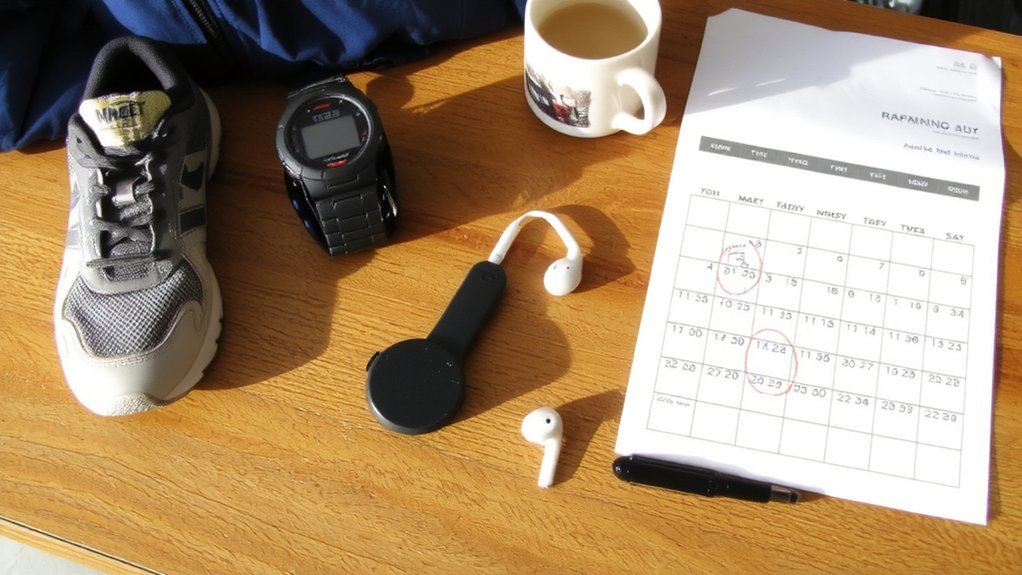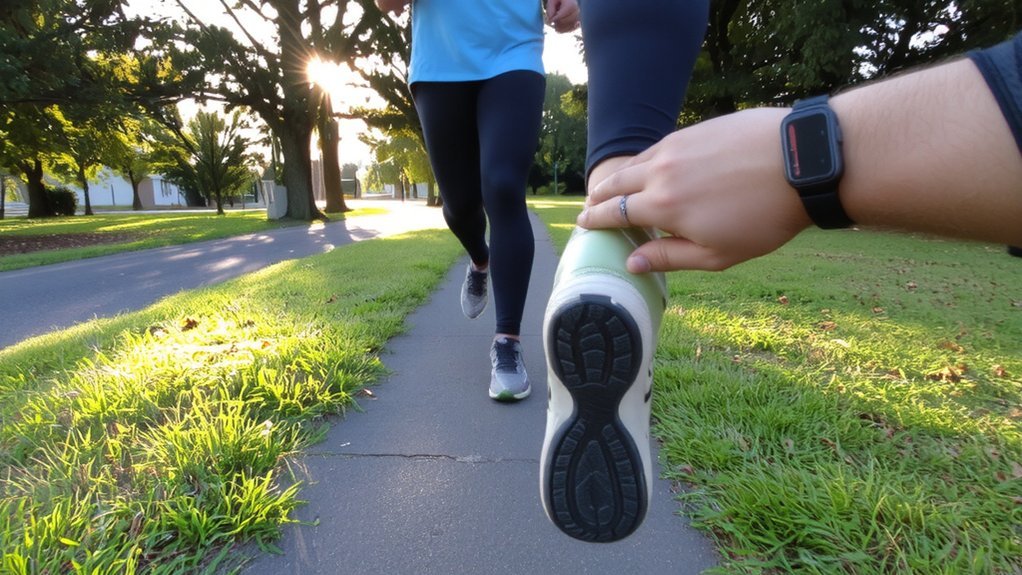If you want to start running, you should begin by building a walking aerobic base and using conservative run/walk intervals to protect your joints and learn pacing. You’ll train three times a week, add strength and cross‑training, and progress slowly. I’ll give concrete interval ratios, a weekly plan, and injury‑prevention tips—keep going to get the practical steps.
Why Start With Run/Walk Intervals

Starting with run/walk intervals lets you build endurance without overtaxing your body, so you’ll stick with the habit longer.
You alternate short runs with brisk walks to control intensity, limit fatigue, and lower injury risk.
That rhythm helps you run faster segments without gasping and finish workouts feeling capable, not wrecked.
Intervals teach pacing: you learn how effort feels at different speeds and recoveries, which makes progress predictable.
They also protect joints and tendons while muscles adapt, so you can increase running time gradually.
Mentally, short running bursts feel achievable, which keeps motivation high and reduces dread.
Use simple timers or a phone app, track intervals, and increase run time slowly as your comfort and confidence grow.
Celebrate small wins to reinforce the habit.
Build a Walking Aerobic Base First

Before you add running, build a walking aerobic base so your heart, lungs, and muscles can adapt without excess strain.
Start with brisk walks most days, 30 to 60 minutes at a pace that raises your breathing but still lets you hold a conversation.
Increase total weekly time gradually, adding five to ten minutes or one extra session each week.
Include varied terrain and gentle hills to strengthen legs and improve balance.
Wear supportive shoes and focus on upright posture, short strides, and relaxed shoulders. Monitor effort by talking rather than pace: if you can speak in full sentences, you’re in the aerobic zone.
Rest when you need to, stay hydrated, and aim for consistent weeks before introducing any running and build confidence steadily.
Beginner-Friendly Interval Ratios and Plans

Once you’ve built a walking aerobic base, add short run/walk intervals to safely increase intensity and confidence.
Start with conservative ratios like 20 seconds running, 2 minutes walking (20:120) or 30:90. Repeat for 15–20 minutes total, including warm-up and cooldown walks.
After one to three sessions, shift to 1:2 (run 1 minute, walk 2) then 1:1, then 2:1 as you feel comfortable.
Keep running pace conversational; breathe steadily and watch form.
If you feel undue fatigue or pain, drop back a ratio or shorten repeats.
Every progression should feel manageable and sustainable.
Use intervals during a single workout rather than trying to run continuously until you can hold 20–30 minutes at easy pace.
Track your progress and celebrate small improvements along the way regularly.
Weekly Frequency and Scheduling Recommendations

If you’re new to running, aim for three nonconsecutive run/walk sessions per week, with rest or low‑impact cross‑training days between so your body can adapt and you avoid overuse.
Keep two full rest days or active recovery sessions like walking, swimming, or yoga; they speed recovery and reduce injury risk.
Gradually add a fourth run after four to six weeks if you feel strong, increasing total weekly volume by no more than ten percent.
Use one session for slightly longer duration and others for shorter, easy efforts or structured intervals (short bursts with recovery). Track sessions and sensations to judge recovery.
Be flexible: shift days for life events, but preserve rest and progression to build consistency and resilience over months, not days. Expect gradual improvements.
How to Pace Your Easy Runs

How fast should you run on your easy days? You should run slow enough to recover, build aerobic fitness, and enjoy the run.
Keep effort conversational: you can speak in full sentences without gasping. If you use pace, aim about one and a half to two minutes slower per mile than your hard workouts.
If you watch heart rate, stay in zone two, where breathing is steady. Run by feel when weather or fatigue change; it’s fine to go slower.
Don’t push hard because you feel good; easy runs promote adaptation and consistency. Finish relaxed, with form intact, and prioritize regularity over speed.
If unsure, slow down; you’ll recover better and improve over time. Make easy days enjoyable, short term gains follow long term.
Progressing Your Run Intervals and Mileage
Gradually increasing your intervals and weekly mileage keeps progress steady and injury risk low.
Start by lengthening run segments by 30 to 60 seconds, or adding one minute per interval each week, depending on how you feel.
Increase total weekly mileage by no more than about ten percent to limit overload.
Alternate harder interval or longer runs with easy, shorter days so you recover.
Every third or fourth week, cut volume back by 20 to 30 percent to consolidate gains.
Prioritize sleep, hydration, and easy pace on recovery days so workouts remain high quality.
Watch for persistent soreness, unusual fatigue, or declining performance — those signal you’ll need more rest.
Track workouts so you adjust increments responsively and keep progress sustainable over weeks ahead.
Strength Training and Cross-Training for Beginners
Adding targeted strength work and low-impact cross-training will make your running stronger and more resilient while helping you recover from harder sessions.
Aim for two short strength sessions per week focusing on glutes, hips, core and single-leg stability—think squats, lunges, deadlifts, planks and step-ups with 2–3 sets of 8–12 reps. Keep sessions 20–30 minutes.
Add one to two cross-training days like cycling, swimming, or elliptical for 30–45 minutes at easy to moderate intensity to build aerobic base without extra pounding.
Use mobility and foam rolling after workouts to maintain range of motion. Schedule hard runs and intervals apart from strength days when possible, and reduce intensity the day before a key run so you’re fresh.
Track progress and adjust load gradually each month, consistently.
Avoiding Common Beginner Mistakes and Injuries
Because your body adapts slowly, don’t jump mileage, speed, or frequency—build one variable at a time and back off at the first sharp pain.
Don’t ignore persistent niggles; they signal overload before a full injury.
Progress with planned increments like 10% weekly or increase time, not intensity.
Keep your cadence moderate and avoid exaggerated overstriding that stresses knees and hips.
Include easy days and full rest days; tissues need downtime to strengthen.
Use strength work to balance running muscles and reduce imbalance-related injuries.
Vary routes and surfaces to avoid repetitive loading.
Warm up briefly before runs and cool down afterward to maintain mobility.
If pain alters your gait, stop and seek assessment rather than toughing it out.
Don’t hesitate to modify your plan promptly.
Practical Gear, Safety, and Recovery Tips
Having learned to manage load and nip niggles early, you also need the right gear, safety habits, and recovery routines to keep training consistent.
Choose shoes that fit your gait and replace them every 300–500 miles; get moisture-wicking clothes and reflective gear for low light.
Carry ID, a charged phone, and a small amount of cash; tell someone your route.
Warm up with dynamic drills, cool down with easy jogging and stretching, and prioritize sleep and nutrition to repair tissue.
Use foam rolling and brief ice or heat for soreness, but avoid overuse of painkillers.
Build rest days into plans and progress gradually; consistency beats intensity when you’re starting out.
Track workouts to notice patterns, and consult a professional if pain persists, seek care.
Conclusion
Start slowly and build consistency: walk briskly most days to develop aerobic fitness, then use conservative run/walk intervals (for example, 20 seconds running/2 minutes walking) three times a week. Progress only when you feel ready, add hip and core strength work, include cross‑training and rest days, wear supportive shoes, and listen to pain. By increasing time gradually, pacing easy, and prioritizing recovery, you’ll enjoy safer, sustainable running progress and reach your goals steadily and confidently.